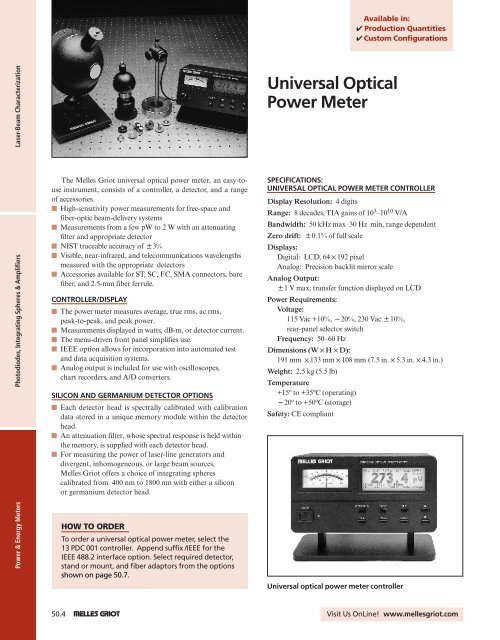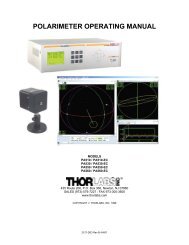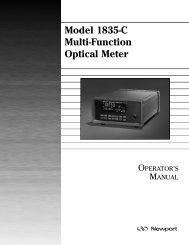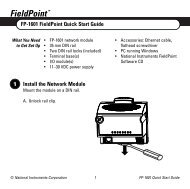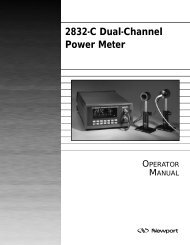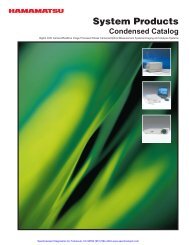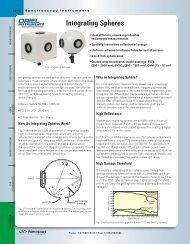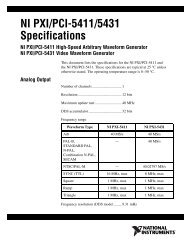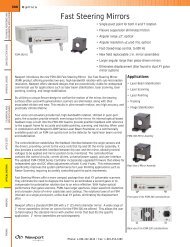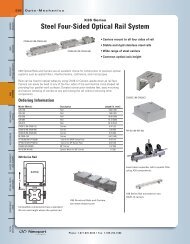Universal Optical Power Meter - Spectroscopic
Universal Optical Power Meter - Spectroscopic
Universal Optical Power Meter - Spectroscopic
Create successful ePaper yourself
Turn your PDF publications into a flip-book with our unique Google optimized e-Paper software.
Available in:<br />
✔ Production Quantities<br />
✔ Custom Configurations<br />
Laser-Beam Characterization<br />
<strong>Universal</strong> <strong>Optical</strong><br />
<strong>Power</strong> <strong>Meter</strong><br />
Photodiodes, Integrating Spheres & Amplifiers<br />
<strong>Power</strong> & Energy <strong>Meter</strong>s<br />
The Melles Griot universal optical power meter, an easy-touse<br />
instrument, consists of a controller, a detector, and a range<br />
of accessories.<br />
$ High-sensitivity power measurements for free-space and<br />
fiber-optic beam-delivery systems<br />
$ Measurements from a few pW to 2 W with an attenuating<br />
filter and appropriate detector<br />
$ NIST traceable accuracy of 83%<br />
$ Visible, near-infrared, and telecommunications wavelengths<br />
measured with the appropriate detectors<br />
$ Accessories available for ST, SC, FC, SMA connectors, bare<br />
fiber, and 2.5-mm fiber ferrule.<br />
CONTROLLER/DISPLAY<br />
$ The power meter measures average, true rms, ac rms,<br />
peak-to-peak, and peak power.<br />
$ Measurements displayed in watts, dB-m, or detector current.<br />
$ The menu-driven front panel simplifies use.<br />
$ IEEE option allows for incorporation into automated test<br />
and data acquisition systems.<br />
$ Analog output is included for use with oscilloscopes,<br />
chart recorders, and A/D converters.<br />
SILICON AND GERMANIUM DETECTOR OPTIONS<br />
$ Each detector head is spectrally calibrated with calibration<br />
data stored in a unique memory module within the detector<br />
head.<br />
$ An attenuation filter, whose spectral response is held within<br />
the memory, is supplied with each detector head.<br />
$ For measuring the power of laser-line generators and<br />
divergent, inhomogeneous, or large beam sources,<br />
Melles Griot offers a choice of integrating spheres<br />
calibrated from 400 nm to 1800 nm with either a silicon<br />
or germanium detector head.<br />
HOW TO ORDER<br />
To order a universal optical power meter, select the<br />
13 PDC 001 controller. Append suffix /IEEE for the<br />
IEEE 488.2 interface option. Select required detector,<br />
stand or mount, and fiber adaptors from the options<br />
shown on page 50.7.<br />
SPECIFICATIONS:<br />
UNIVERSAL OPTICAL POWER METER CONTROLLER<br />
Display Resolution: 4 digits<br />
Range: 8 decades, TIA gains of 10 3 –10 10 V/A<br />
Bandwidth: 50 kHz max–30 Hz min, range dependent<br />
Zero drift: 80.1% of full scale<br />
Displays:<br />
Digital: LCD, 64!192 pixel<br />
Analog: Precision backlit mirror scale<br />
Analog Output:<br />
81 V max; transfer function displayed on LCD<br />
<strong>Power</strong> Requirements:<br />
Voltage:<br />
115 Vac +10%, 420%, 230 Vac 810%,<br />
rear-panel selector switch<br />
Frequency: 50–60 Hz<br />
Dimensions (W!H!D):<br />
191 mm !133 mm!108 mm (7.5 in.!5.3 in.!4.3 in.)<br />
Weight: 2.5 kg (5.5 lb)<br />
Temperature<br />
+15º to +35ºC (operating)<br />
520º to +50ºC (storage)<br />
Safety: CE compliant<br />
<strong>Universal</strong> optical power meter controller<br />
50.4 1 Visit Us OnLine! www.mellesgriot.com
detector heads<br />
13 PDH 001 (Si) or<br />
13 PDH 101 (Ge)<br />
67 mm integrating<br />
sphere with detector<br />
13 PDH 005 (Si) or<br />
13 PDH 105 (Ge)<br />
stand<br />
13 PDA 015 adjustable mount<br />
07 PBS 003<br />
Detector options for the universal optical power meter<br />
PHOTODIODES<br />
INTEGRATING SPHERES, AND AMPLIFIERS<br />
For information on the complete Melles Griot line of<br />
photodiodes and high-frequency, wide-bandwidth,<br />
and large-dynamic-range amplifiers, see Chapter 49,<br />
Photodiodes, Integrating Spheres, and Amplifiers.<br />
POWER<br />
ON<br />
<strong>Universal</strong> <strong>Optical</strong> <strong>Power</strong> <strong>Meter</strong><br />
METER ZERO<br />
NULL<br />
SETUP<br />
RANGE<br />
SELECT<br />
13 PDC 001,<br />
13 PDC 001/IEEE<br />
152 mm integrating<br />
sphere with detector<br />
13 PDH 003 (Si)<br />
adjustable mount<br />
07 PBS 003<br />
LASER BEAM CHARACTERIZATION<br />
For information on a wide variety of instruments that<br />
measure beam width, intensity profile, pointing<br />
stability, and other parameters, see Chapter 48,<br />
Laser Beam Characterization.<br />
Laser-Beam Characterization Photodiodes, Integrating Spheres & Amplifiers <strong>Power</strong> & Energy <strong>Meter</strong>s<br />
Visit Us Online! www.mellesgriot.com 1 50.5
Laser-Beam Characterization<br />
<strong>Universal</strong> <strong>Optical</strong> <strong>Power</strong> <strong>Meter</strong> Controllers<br />
PRODUCT NUMBER<br />
Without IEEE Interface<br />
13 PDC 001<br />
With IEEE Interface<br />
13 PDC 001/IEEE<br />
Note: A controller system comprises, at a minimum , a controller, detector, and stand.<br />
Detectors for <strong>Universal</strong> <strong>Optical</strong> <strong>Power</strong> <strong>Meter</strong><br />
Photodiodes, Integrating Spheres & Amplifiers<br />
Detector Options 1 Wavelength (nm) <strong>Power</strong> NEP 2 Accuracy 3 (%) PRODUCT NUMBER<br />
Silicon<br />
Detector Head Only<br />
(10-mm clear aperture)<br />
152-mm Integrating<br />
Sphere and Detector<br />
67-mm Integrating<br />
400–1100<br />
400–1100<br />
400–1100<br />
@ 630 nm<br />
5 pW–1 mW<br />
5 nW–2 W<br />
(with attenuator)<br />
2 nW –400 mW<br />
250 pW–50 mW<br />
5 pW<br />
5 nW<br />
(with attenuator)<br />
2 nW<br />
250 pW<br />
83<br />
85<br />
(with attenuator)<br />
810<br />
810<br />
13 PDH 001<br />
13 PDH 003<br />
13 PDH 005<br />
Sphere and Detector<br />
Germanium<br />
Detector Head<br />
(4.8-mm clear aperture)<br />
67-mm Integrating<br />
Sphere and Detector<br />
800–1800<br />
800–1800<br />
@ 1500 nm<br />
10 nW–1 mW<br />
10 mW–200 mW<br />
(with attenuator)<br />
500 nW–50 mW<br />
10 nW<br />
10 mW<br />
(with attenuator)<br />
500 nW<br />
85<br />
810<br />
(with attenuator)<br />
810<br />
13 PDH 101<br />
13 PDH 105<br />
1 All detectors have an integrated cable ≥1.5 m long.<br />
2 Specified at peak response.<br />
3 1% of reading or full scale, whichever is greater.<br />
Fiber Adaptors*<br />
PRODUCT NUMBER<br />
<strong>Power</strong> <strong>Meter</strong> Accessories<br />
<strong>Power</strong> <strong>Meter</strong> Accessories<br />
PRODUCT NUMBER<br />
<strong>Power</strong> & Energy <strong>Meter</strong>s<br />
ST Connector Adaptor<br />
SC Connector Adaptor<br />
FC Connector Adaptor<br />
SMA Connector Adaptor<br />
Bare-Fiber Connector Adaptor<br />
2.5-mm Ferrule Adaptor<br />
13 PDA 001<br />
13 PDA 003<br />
13 PDA 005<br />
13 PDA 007<br />
13 PDA 009<br />
13 PDA 011<br />
*Compatible with detector heads 13PDH 001, 005, 101, 105. Requires 13 PDA 013 for use<br />
with 13 PDH 003.<br />
Fiber Adaptor Interface for 152-mm Integrating Sphere<br />
13 PDA 013<br />
Stand for Either Silicon or Germanium Detector Heads<br />
13 PDA 015<br />
Adjustable Mount for Either 67 or 152-mm<br />
Integrating Sphere (inch/metric)<br />
07 PBS 003 / 07 PBS 503<br />
<strong>Universal</strong> Base Plates (inch/metric)<br />
07 BPS 003 / 07 BPS 503<br />
50.6 1 Visit Us OnLine! www.mellesgriot.com
FUNDAMENTALS OF INTEGRATING SPHERES<br />
In many photodetector applications it is necessary to measure the absolute or relative intensity of a divergent source<br />
or an inhomogeneous beam that is much larger than the active area of a photodetector. In those situations,<br />
integrating spheres are used to scramble or average light by multiple diffuse reflections in order to obtain meaningful<br />
intensity measurements. An integrating sphere is a hollow sphere (often aluminum) whose entire inner surface is<br />
uniformly coated with a layer of material that has a high diffuse reflectance.<br />
When light from a source enters an integrating sphere, it loses all memory of direction and polarization. At the exit<br />
port, the light intensity is uniform and diffuse. Although other methods have been developed to deal with the<br />
problems of averaging the intensity of an inhomogeneous source or of a wide-angle beam, an integrating sphere is the<br />
best solution in many applications. In fact, the only real differences between the integrating spheres of today and the<br />
spheres of many years ago are the improved quality and stability of the diffuse reflective coatings.<br />
PERFORMANCE CHARACTERISTICS<br />
Throughput and stability are two meaningful figures of merit for integrating spheres. Throughput is defined as the<br />
ratio of the flux exiting the sphere to the flux entering the sphere. It is determined by the size of the input and exit<br />
ports relative to the sphere area and by the reflectivity:<br />
AR e<br />
Throughput =<br />
1 4 R1 4 A<br />
[ ( p)<br />
]<br />
where A e is the area of the exit port divided by the total sphere area<br />
R is the reflectance of the coating<br />
A p is the total area of all ports divided by total sphere area.<br />
Stability is the reciprocal of the change in throughput with respect to the change in reflectivity of the coating. This is<br />
an important parameter since, in certain operating environments, the reflectivity of the coating may degrade slightly<br />
over a long period of time and the degradation may be nonuniform over the sphere surface. A small change in the<br />
reflectivity of a low-stability sphere will result in a large change in throughput. Therefore, a low-stability sphere is less<br />
likely to give an accurate, reproducible reading than a high-stability sphere. Stability is related to throughput. A highthroughput<br />
sphere is inherently less stable than a lower throughput sphere because of the nonlinear dependence of<br />
throughput on reflectivity.<br />
Stable spheres have reflectivity values of 90% or less, whereas low-stability (high-throughput) spheres typically have<br />
reflectivities of 79% or higher. For example, a typical low-throughput sphere with a 90% reflectivity coating will have<br />
an inherent stability of 0.5, whereas an identical high-throughput sphere with a 99% reflectivity coating will have a<br />
stability factor of 0.05.<br />
Integrating spheres are available as components in Chapter 49, Photodiodes, Integrating Spheres, and Amplifiers.<br />
Laser-Beam Characterization Photodiodes, Integrating Spheres & Amplifiers <strong>Power</strong> & Energy <strong>Meter</strong>s<br />
Visit Us Online! www.mellesgriot.com 1 50.7


